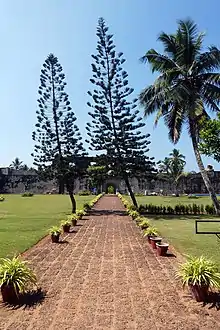Anchuthengu Fort
Anchuthengu Fort (also known as Anjengo Fort) was established by the British East India Company (EIC) in 1696 after the Queen of Attingal gave permission in 1694 for the company to do so. The fort was located near the town of Anchuthengu. The forts served as the first signalling station for ships arriving from England.[1]

The fort was the East India Company's first permanent post on the Malabar Coast. The EIC commenced construction in January 1696. In June 1696 British pirates in the ketch Josiah under Robert Culliford, destroyed the Bengal Pilot Service's sloop Gingali (or Gingalle) at Anjengo.[2][3] In 1697 locals attacked the fort, which was not complete, but the English prevailed.[4]
The EIC completed the fort in 1699. The fort is 256 ft (78.0 m) square, with four bastions, each of which mounted eight 18-pounder guns. The walls between the bastions had seven or eight guns. In addition, there was a battery of some twenty 18&24-pounder guns facing the sea. The fort had a garrison of 400 Europeans and 70-80 topasses.[5] Originally Anjengo was second in importance to the EIC only to Bombay Castle.

Of more importance than the attack in 1697 was the rebellion at Attingal on 15 April 1721. Local notables, who objected to the EIC's policy of ignoring them while providing the Queen with gifts, attacked a 140-man EIC expedition bringing gifts to the Queen from Anjengo fort, some 10 miles away. After massacring the expedition the locals besieged the fort. The EIC sent a relief force from Thalassery that ended the siege.
The fort played an important role in the Anglo-Mysore Wars. During the Anglo-Mysore wars the EIC stored ammunition at the fort.
In 1792 the EIC reduced Anjengo's formal status to that of a Residency. In 1810 the EIC abolished the Commercial Residency at Anjengo and handed over the responsibility for the fort to the Political Agent at Travancore. In 1813 the factory was closed.[6]
Other
In 1748 the Bombay Dockyard built the snow Luconia for the Anjengo Pilot Service.[7] In 1802 Anjengo, a ship of 260 tons (bm) was built at Anjengo, the first vessel of that large a size.[8] The owner, John Tady Dyne, was one of the last EIC residents at Anjengo.[9]
Citations and references
Citations
- Sathyendran, Nita (26 January 2012). "Hidden 100: In the land of five coconut palms". The Hindu. Retrieved 29 November 2012.
- Hackman (2001), p. 331.
- Grey & MacMunn (1933), p. 133.
- More (2003), pp.75-6.
- More (2003), pp.80-1.
- Menon (1924), p. 347.
- Wadia (1986), p. 330.
- Phipps (1840), p. 174.
- Calcutta Review (October 1898), Vol. 107, №214, p.211.
References
- Grey, Charles (1933). MacMunn, General Sir George (ed.). Pirates Of The Eastern Seas (1618-1723), A Lurid Page of History. Sampson Low, Marston.
- Hackman, Rowan (2001). Ships of the East India Company. Gravesend, Kent: World Ship Society. ISBN 0-905617-96-7.
- Koshy, M.O. (1988) "Massacre of the English at Anjengo". Journal of Kerala Studies, Vol. 15, pp.83-93.
- Menon, Krishnat P. Padmanabha (1924). A History of Kerala: Written in the Form of Notes on Visscher's Letters from Malabar. 1. Cochin Government Press.
- More, Lena (2003). English East India Company and the local rulers in Kerala: a case study of Attingal and Travancore. IRISH. ISBN 81-88432-04-0.
- Phipps, John (1840). A Collection of Papers Relative to Ship Building in India ...: Also a Register Comprehending All the Ships ... Built in India to the Present Time ... Scott.
- Wadia, R. A. (1986) [1957]. The Bombay Dockyard and the Wadia Master Builders. Bombay.
External links
| Wikimedia Commons has media related to Anchuthengu Fort. |